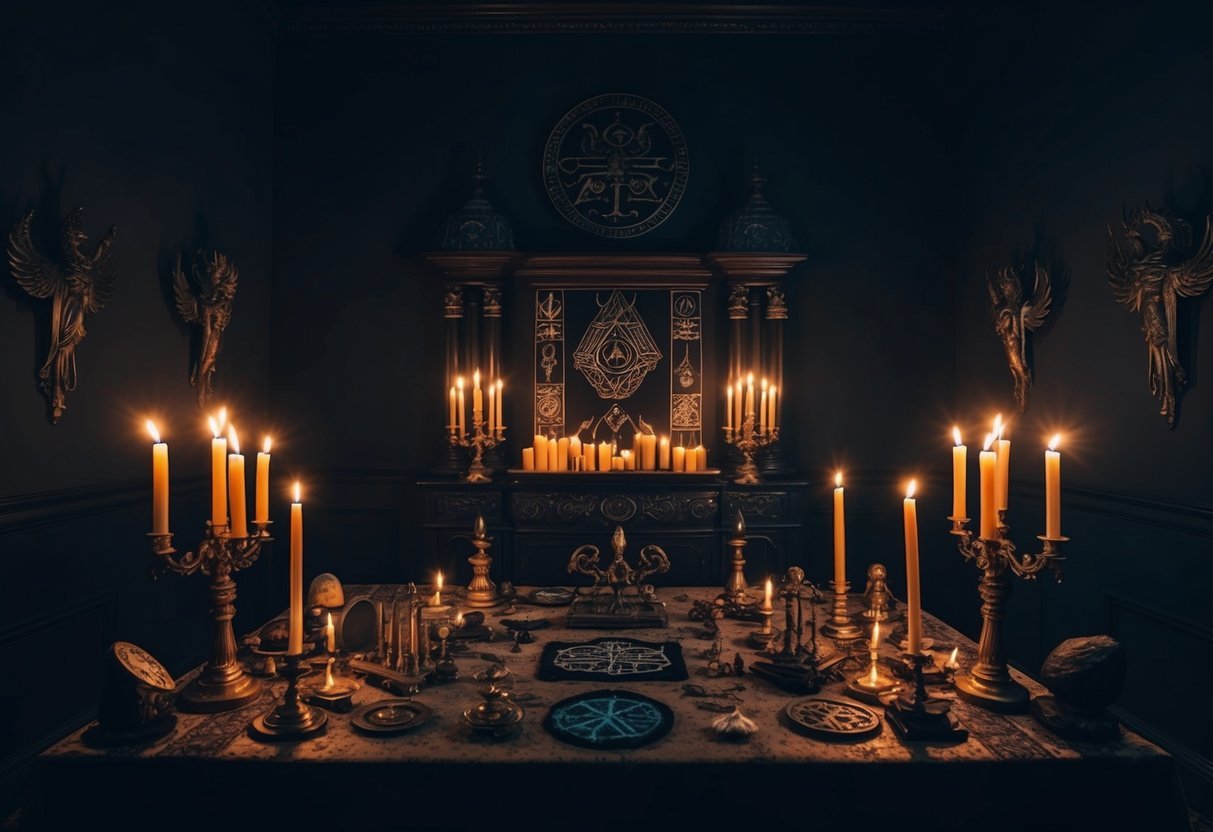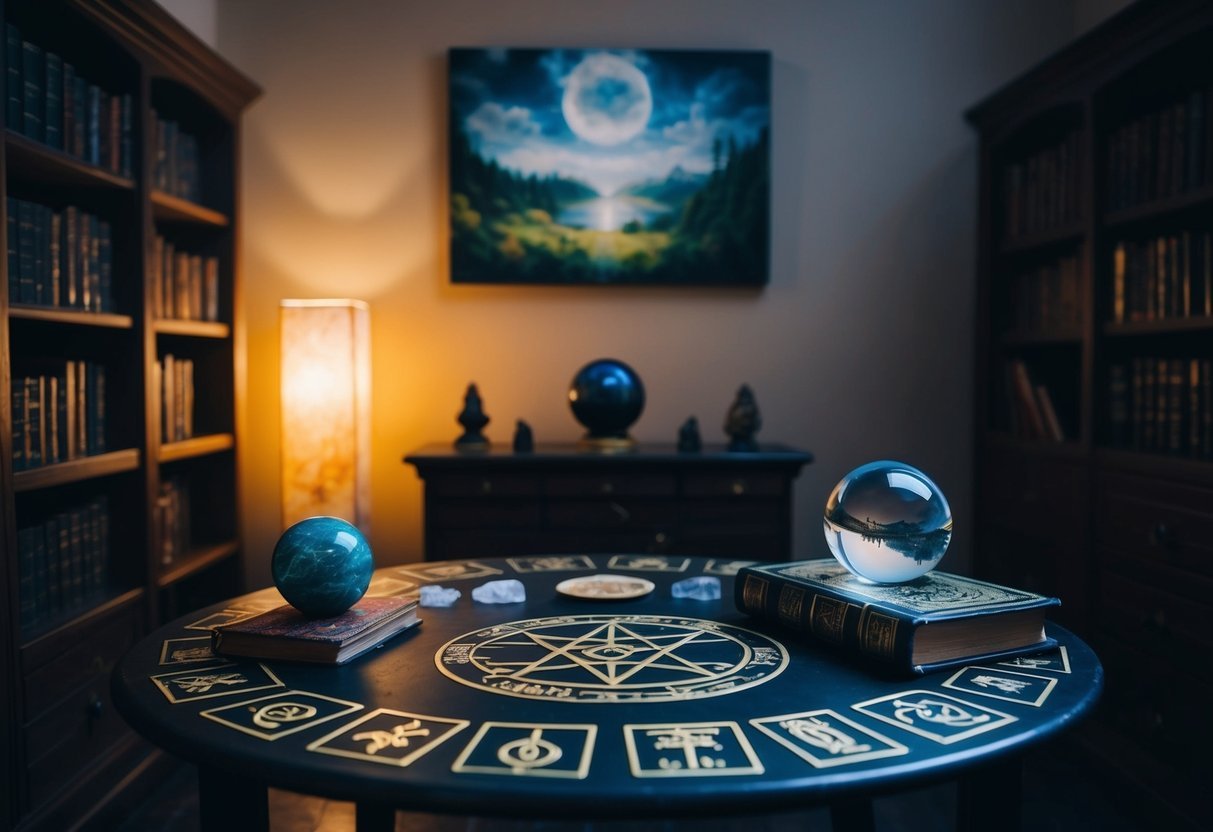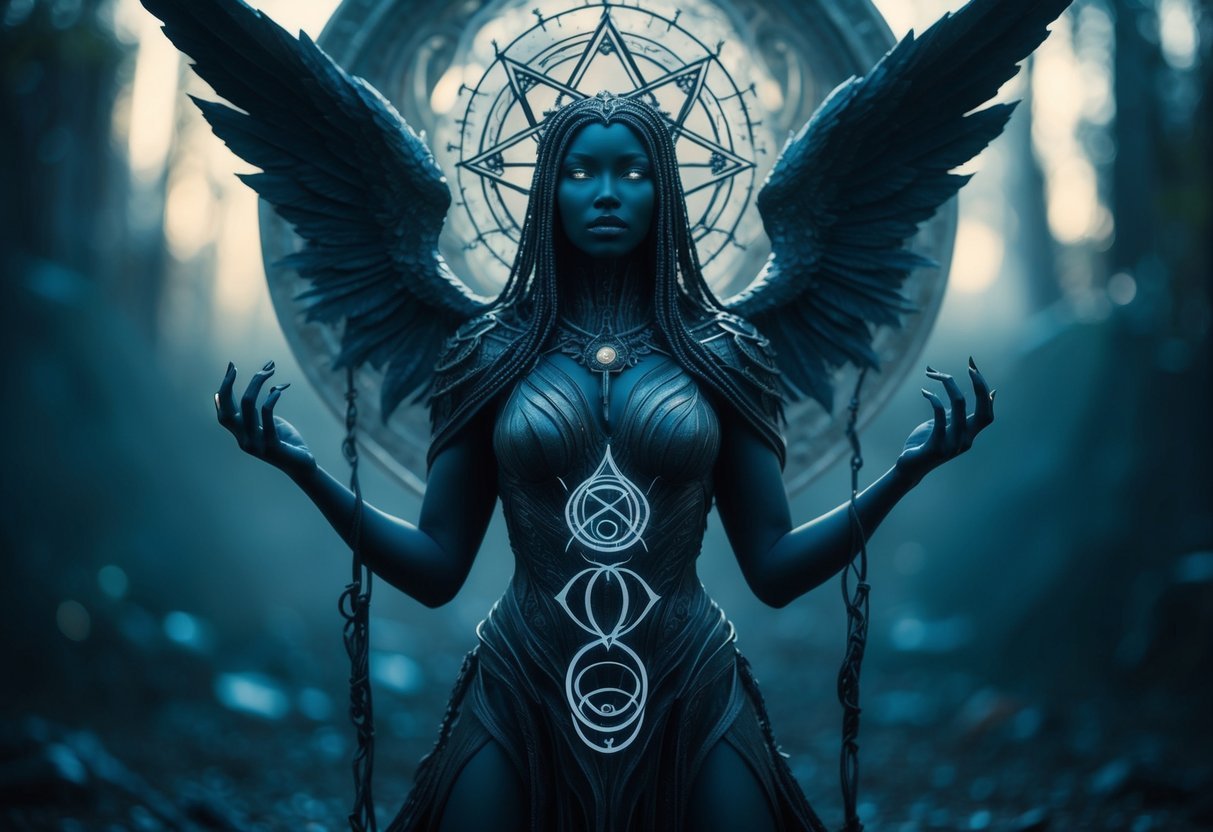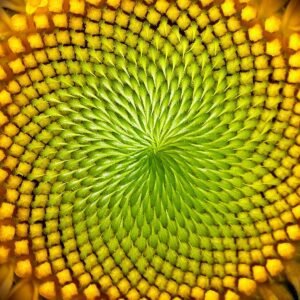Exploring the intricate relationship between the occult and fine art reveals a world of hidden meanings and symbolic representations. Occult influences have permeated art history, offering artists a unique lens through which to engage with and critique culture. From medieval alchemical symbolism to the mystical elements in the works of the Symbolists, these influences have provided a rich tapestry of imagery and themes.

The impact of esoteric and mystical ideologies can be traced through various artistic movements, such as Surrealism and Abstract Expressionism. Artists like Wassily Kandinsky, although not primarily associated with the occult, engaged with its ideologies and incorporated them into abstract art. This engagement invites viewers to contemplate the spiritual and hidden dimensions of existence, merging the mystical with the visual.
In contemporary art, the occult continues to inspire and challenge perceptions. Artists explore this theme as a form of political and social commentary, illustrating how occult concepts intersect with issues of gender, race, and identity. Through exhibitions and public discourse, the impact of these representations continues to evolve, demonstrating that the allure of the occult in fine art is far from being confined to history.
Key Takeaways
- Occult themes add layers of symbolism and meaning to art.
- Artists use occult concepts to explore cultural and social themes.
- Contemporary works engage with the occult as both inspiration and critique.
Historical Context and Evolution of the Occult in Art
The interplay between the occult and art spans centuries, manifesting through various symbols and esoteric practices. From the mysterious iconography of ancient civilizations to the spiritual explorations of modern artists, the influence of the occult can be seen across different periods.
Ancient and Medieval Occult Depictions
In ancient civilizations, art often intertwined with occultic practices like alchemy and witchcraft. Iconography from Egypt, Babylon, and Greece depicted scenes filled with mystical symbols. Such imagery was not merely decorative; it served as a bridge between the physical and spiritual worlds.
During the medieval era, this tradition persisted. Manuscripts and tapestries echoed tales of mysticism, blending Christian symbols with pagan elements. These artworks often illustrated the quest for hidden knowledge, aligning closely with the spiritual practices of the time.
Renaissance and Baroque Esoteric Imagery
The Renaissance era witnessed a resurgence of mystical themes within art, deeply influenced by figures like Leonardo da Vinci and Michelangelo. Their works frequently incorporated alchemical symbols and esoteric philosophies. The fascination with spirituality and human potential was reflected in intricate details of their masterpieces.
In the Baroque period, artists such as Caravaggio and Raphael continued to explore these themes. Their paintings often depicted dramatic spiritual narratives, bringing occult themes into a more accessible form. This period saw a blending of religious and occult elements, fostering a rich tapestry of symbolic expression.
Modern Art and Occultism
Modern art embraced the occult through abstraction and symbolism. Artists sought to convey spiritual ideas by pushing the boundaries of traditional representation. The development of movements like Symbolism and Surrealism highlighted a renewed interest in esoteric concepts.
Influences from the occult were evident in the works of artists who explored themes of mysticism and spiritual awakening. This period marked a significant transformation, as the occult shifted from hidden undertones to overt expressions within the art world. Enthralled by the possibilities of new perspectives and spiritual insights, these artists contributed to a broader understanding of the unseen forces in art.
Symbolism and Hidden Meanings in Occult Art

The integration of occult symbols in art reveals deeper meanings by delving into the mystical and esoteric aspects of various traditions. This section explores how symbols from alchemy, sacred geometry, tarot, and astrology are utilized to convey profound concepts and spiritual beliefs.
Alchemical Symbols and Their Interpretations
Alchemical symbols in art often represent the transformative processes of nature and the human soul. Common alchemical symbols include the philosopher’s stone, believed to transform base metals into gold, and mercury, symbolizing the fluid connection between the material world and the divine. These symbols suggest a journey of spiritual enlightenment and the quest for eternal wisdom.
Alchemists used imagery of the sun and moon to depict balance and duality, while the ouroboros, a serpent eating its own tail, signifies the eternal cycle of life, death, and rebirth. Each of these symbols carries layers of meaning that artists use to convey an understanding of the universe’s hidden secrets.
Mystical Themes and Sacred Geometry
Sacred geometry is deeply rooted in the mysticism of the occult, emphasizing perfection and unity. Shapes such as circles, triangles, and hexagons hold spiritual significance, representing concepts like infinity, harmony, and balance. These geometric designs can be found in various artworks, highlighting the belief in an underlying universal order.
The use of sacred geometry is not only aesthetically pleasing but also symbolically potent, often echoing the belief that the cosmos is constructed on mathematical and geometric principles. Through its intricate patterns, artists aim to express the interconnectedness of all things and the divine architecture of the cosmos.
Tarot and Astrological Signs in Art
The tarot is rich in symbols that resonate with themes of fate, destiny, and personal growth. Frequent motifs include the fool, symbolizing new beginnings and unbridled potential, and the magician, which denotes mastery and skillful use of one’s talents. These cards often appear in artworks to evoke introspection and spiritual awareness.
Astrological signs convey characteristics associated with the zodiac. Each sign possesses symbolic meanings, like Aries with courage or Libra with balance. By incorporating these signs into art, artists reflect on human nature and the cosmos’ influence on personal and collective destinies. This use of astrological imagery helps viewers connect with deeper spiritual narratives and insights.
Occult and Spirituality in Contemporary Art

Contemporary art frequently explores spiritual and occult themes, reflecting both historical influences and modern interpretations. These creative expressions often appear in various mediums, including visual, new media, and performance art.
Current Occult Art Trends
In contemporary art, artists increasingly explore the intricate connections between spirituality and occult symbolism. This includes a resurgence of interest in ancient symbols and mystical themes. Many artists incorporate elements like alchemy, tarot, and astrology, offering fresh interpretations that resonate with modern audiences.
Artists like Marina Abramovic are known for her explorations of spirituality through performance art. Her work often challenges perceptions and encourages introspective experiences. Meanwhile, visual artists such as Damien Echols use occult motifs to explore deeper existential themes.
The Role of Occultism in New Media and Performance Art
New media and performance art are key platforms for integrating occult themes. The digital arena allows for experimentation with virtual reality and other new technologies. This creates immersive experiences that convey complex mystical ideas and spiritual narratives.
Through performance art, artists engage with audiences on topics like ritual and transcendence. Renowned performers, for example, enhance the interplay between mysticism and art, crafting performances that are as much about process as result. Their work often blurs the line between artist and audience, making the exploration of spirituality an interactive and dynamic experience.
Notable Artists and Their Occult Representation

Artists throughout history have explored the mystical and occult through their work, shaping unique intersections between spirituality and art. This examination reveals how notable figures have drawn from esoteric traditions to push the boundaries of artistic expression.
Influential Historical Figures in Occult Art
William Blake stands out as a pioneering figure. His deeply spiritual and symbolic works often draw upon biblical themes and personal visions. His famous piece, “The Great Red Dragon,” reflects his exploration of mystical themes and the supernatural.
Hilma af Klint’s abstract works predate and influence contemporary abstract art. Her paintings, such as “The Ten Largest,” were inspired by séances and spiritualism. She believed her paintings were guided by mystical forces, contributing significantly to the abstract movement’s development.
Francisco Goya’s work often delves into dark and fantastical themes. His “Black Paintings” series explores haunting subjects, including the supernatural and the macabre. These works reflect his engagement with the darker aspects of the human psyche and society.
Rising Talents and Their Mystic Explorations
Leonora Carrington, a surrealist painter and writer, infused her work with mystical and magical themes. Her paintings, like “The House Opposite,” feature fantastical creatures and dream-like landscapes, influenced by her interest in alchemy and the occult.
Contemporary artists like S. Elizabeth and Scott Treleaven continue to explore mystical themes through various mediums. S. Elizabeth uses mixed media to weave narratives rich with symbolism, while Treleaven’s work in film and photography blends punk aesthetics with occult themes.
These modern creators reflect the ongoing fascination with mystical themes, continuing the legacy of artistic exploration into the unknown. Their works serve as bridges between past and present, continuing the dialogue between spirituality and art.
Intersections of Occult, Gender, and Race

Exploring the intersection of occult, gender, and race reveals how these themes intertwine in art, showcasing both empowerment and marginalization. The representation of witches often emphasizes femininity, while portrayals of occult masculinity display themes of power. Additionally, diversity and inclusion are essential in understanding occult art narratives.
Femininity and Witchcraft in Visual Arts
In visual arts, femininity is frequently linked to witchcraft, highlighting themes of empowerment and resistance. Historically, witches have been depicted as powerful women who defy societal norms. Such representations often reflect societal anxieties about female power and autonomy. Artists like Leonora Carrington have used these motifs to explore themes of identity and transformation.
Witchcraft symbolism can serve as a vehicle for examining gender roles and expectations. By depicting witches, artists challenge conventional portrayals of women, emphasizing strength and independence. The use of the occult serves as a means to both mystify and celebrate feminine power. This artistic approach provides a platform for discussing broader issues of gender, agency, and authority.
Masculinity and Power in Occult Representation
Masculinity within occult representation often involves themes of power and control. Traditional depictions of male figures in the occult associate them with dominance and authority. These portrayals can reinforce societal notions of masculinity as linked to power structures.
Artists sometimes subvert these stereotypes, using occult imagery to critique traditional power dynamics. This can involve reinterpreting male figures within occult contexts, challenging the viewer’s perceptions of gender roles. The interplay between masculinity and occult themes offers a nuanced critique of dominant cultural narratives, reflecting broader discussions about gender and power.
Exploring these depictions allows for critical engagement with how masculinity is constructed and understood within cultural and artistic contexts.
Diversity and Inclusion in Occult Art Narratives
Diversity and inclusion in occult art narratives are crucial for a comprehensive understanding of these themes. Art that incorporates diverse racial and cultural perspectives enriches the dialogue surrounding occult representations. By acknowledging the contributions of various cultures, artists broaden the scope of occult art.
Incorporating diverse voices helps to dismantle homogenized views of occult practices. It encourages examination of how different cultural backgrounds influence the interpretation and depiction of occult themes. For instance, the racialization of the occult, as seen in British novels from 1850-1900, highlights the intersection of scientific and racial discourse.
This approach fosters a more inclusive understanding of how gender and race intersect within the realm of occult art.
Occultism in Various Artistic Mediums
Occultism has been expressed in diverse artistic mediums, from painting to mixed media, providing rich material for interpreting hidden mystical themes. These mediums explore the symbolic representation of occult concepts, often using distinct techniques and styles to convey esoteric messages.
Painting and Illustration
Painting serves as a primary vehicle for expressing occult themes, leveraging techniques like chiaroscuro to enhance mystical and dramatic elements. The use of light and shadow in chiaroscuro helps create contrasts that reveal hidden dimensions, often used to depict mysterious or transcendental experiences. Artists also integrate symbols and metaphors linked to occult rituals, utilizing emblematic imagery such as brooms and witches. This approach enables a deep exploration into spiritual narratives, connecting techniques with esoteric expression.
Illustration often accompanies text related to occult themes, adding visual depth to mystical concepts. Detailed line work and color palettes help evoke specific moods or atmospheres, complementing the narratives they represent. By conveying stories through both literal and abstract visuals, illustration becomes a crucial method for exploring the occult within fine art.
Sculpture and Ceramics
Sculpture and ceramics provide tangible forms to translate occult themes into three-dimensional space. Sculptures of deities or mythical creatures often embody occult ideas, making use of material properties to evoke powerful emotions or signify spiritual protection. This medium enables a tactile exploration of mystical concepts, bridging the gap between the viewer and the esoteric world.
Ceramics, with their connection to earth and alchemy, often embody transformation and mysticism. Artists engage with textures, glazes, and forms to represent the occult, embedding the works with symbolic meanings. This approach highlights the tactile and transformative nature of the medium, encouraging a deeper interaction with the mystical themes.
Mixed Media and Collage Techniques
Mixed media and collage techniques allow artists to integrate diverse elements, offering a composite view of occult ideas. By combining materials such as paper, fabric, and found objects, artists create layered narratives that can be deconstructed visually to uncover hidden meanings. These techniques draw from both artistic and esoteric traditions, engaging with symbolism in unpredictable and innovative ways.
Collage can symbolically represent the piecing together of knowledge, akin to uncovering occult secrets. The intentional juxtaposition of disparate elements encourages viewers to engage with the work dynamically, offering multiple interpretations. This medium effectively communicates complex occult ideas through a richly textured interplay of visuals and materials.
Occult Exhibitions and the Public Reception
Exploring the influence of occult themes across various art exhibitions reveals both intrigue and skepticism from diverse audiences. These exhibitions highlight the complexity of human belief systems and their impact on art. The following sections provide an in-depth look into the global landscape of occult art, public perceptions, and the role of collectors and patrons.
Noteworthy Occult Exhibits Around the World
Occult-themed exhibitions are held in various cultural centers, each offering a unique perspective. For instance, the International Surrealist Exhibition in 1947 displayed works that engaged with occult symbolism, capturing public fascination with spiritual and mystical ideas. In these settings, art not only entertained but provoked thought, challenging conventional interpretations. In London, the 1947 International Surrealist Exhibition exemplified this trend, drawing connections between surrealism and occultism. Exhibitions like these provide visitors an opportunity to transcend everyday experiences. They evoke curiosity about esoteric traditions, encouraging deeper exploration into spiritual and metaphysical realms through visual representation.
Critique and Acceptance of Occult Themes
Public perception of occult art varies significantly. While some view these works as profound and enlightening, others critique them as misleading or controversial. The art of the occult often challenges societal norms, prompting both admiration and disapproval. Cultural backgrounds heavily influence this reception, where some embrace the mystical aspects, while others remain skeptical. In The Place of Enchantment, British occultism is explored to understand its cultural impact. Criticism often stems from a lack of understanding or fear of the unknown, whereas acceptance frequently arises from a desire to grasp deeper truths about existence.
Collecting and Patronage of Occult Art
Collectors and patrons play a crucial role in perpetuating interest in occult art. Their support enables artists to delve into themes that might otherwise remain unexplored. Institutions such as galleries and museums benefit from patronage, allowing them to curate exhibitions that attract curious audiences. Publications like A Dark Muse: A History of the Occult illustrate the evolving narrative of occult representation in fine art. Collectors seek these pieces for their enigmatic allure and historical significance, often amassing collections that are both critically acclaimed and publicly debated.
Influence of Religion and Mysticism on Occult Art
The intersection of religion and mysticism has heavily influenced the representation of occult themes in fine art. This influence is visible in various historical and cultural contexts, illustrating the profound impact of spiritual belief systems on artistic expression.
Christian Mysticism and Religious Symbolism
Christian mysticism has profoundly shaped occult art, emphasizing the sacred and divine. Artists often draw on religious symbolism to convey spiritual truths and deeper meanings. Christian symbols like the cross and the halo are frequently incorporated into occult artworks to suggest a mystical experience. This approach reflects the idea of art as a spiritual journey or a form of religious devotion.
In the context of Christian mysticism, divine inspiration is depicted through angelic figures and sacred architecture. Such elements serve as visual metaphors for the presence of the divine. These artworks invite viewers to contemplate their own spirituality and the mystical aspects of their faith.
Non-Western Occult Practices and Their Depictions
Non-Western cultures contribute rich occult traditions to art, intertwining religious rituals and mysticism. Islamic art, for example, often employs geometric patterns and calligraphy to convey spiritual concepts. These elements reflect the divine nature of creation, embodying a sense of order and harmony.
Eastern mysticism, such as in Hinduism and Buddhism, also influences occult art. Mandalas and sacred symbols in these traditions are visual representations of the universe’s spiritual balance. They serve as meditative tools, guiding both the artist and the viewer towards enlightenment. The integration of these traditions in global art highlights the universal nature of mysticism.
Theosophy and Esoteric Religious Movements
Theosophy and other esoteric movements provide a framework for understanding occult art through a mystical lens. Rooted in the belief of hidden truths that transcend traditional dogma, theosophical art seeks to depict the spiritual dimensions of existence. Artists inspired by theosophy often explore themes of reincarnation, karma, and the cosmic order.
Esoteric religious movements, including Kabbalah, have also influenced occult representations. Such traditions emphasize hidden knowledge and the mystical interpretation of religious texts. This intellectually rich approach encourages artists to visualize complex theological concepts, promoting an exploration of the connection between the material and the mystical.
Reflection and Contemplation in Occult Art
Occult art often serves as a medium for exploring spiritual dimensions and contemplating hidden knowledge. This section delves into how art enables introspection and transformation, shedding light on its spiritual and therapeutic roles.
Art as a Tool for Spiritual Exploration
Occult art provides a canvas for spiritual exploration through symbolic representations and abstract forms. Many artists use alchemical symbols and esoteric motifs to unlock spiritual consciousness, engaging viewers in a journey of introspection. This exploration is not just visual but also intellectual and emotional, as the complexity of alchemy and mystical traditions permeates these works.
The process of engaging with occult art often becomes a spiritual practice in itself. As individuals interact with these pieces, they are encouraged to delve deeper into their own beliefs, prompting a reevaluation of personal and universal truths. The interplay of color, form, and hidden meanings offers a meditative experience that transcends ordinary perception, allowing both artists and viewers to touch the realm of the mystical.
The Therapeutic and Transformative Power of Occult Art
Occult art possesses a therapeutic and transformative power that serves as a conduit for healing and personal growth. Engaging with such art can facilitate reflection, allowing individuals to process deep emotional and spiritual experiences. This form of art acts as a mirror, reflecting hidden aspects of the psyche and encouraging holistic healing.
Transformation occurs when this art aids in shifting perspectives or breaking down psychological barriers. Through meditation and contemplation on occult imagery, individuals can experience profound personal change. This transformative aspect connects to spiritual practices that aim to elevate consciousness by bridging the gap between the material and the spiritual. The art form serves not just as an aesthetic experience but as a powerful instrument of inner change.
Frequently Asked Questions
Art and the occult have intertwined in various forms, reflecting mystical and esoteric themes through symbolism and allegory. This section explores how these elements manifest in classical and modern art while highlighting some renowned artists and artworks.
What constitutes occult symbolism in classical fine art works?
Occult symbolism in classical fine art often includes mystical symbols, alchemical elements, and astrological motifs. These symbols were intended to convey deeper spiritual meanings or hidden knowledge. Artists sometimes used these motifs to explore themes of transformation, transcendence, and the unseen world beyond physical reality.
How do art historians interpret occult themes in art history?
Art historians analyze occult themes by examining the historical and cultural context in which the art was created. They look for symbolic representations that align with historical occult practices, such as alchemy and mysticism. Interpretations may involve understanding the artist’s intention and the contemporary audience’s perception of occult themes.
Can you name some famous pieces of art that contain occult elements?
Several renowned artworks contain occult elements. For instance, works by William Blake frequently incorporate mystical symbolism. Another example is the mystical imagery found in the paintings of Albrecht Dürer, such as the Melencolia I, which is teeming with alchemical symbols.
Who are some well-known artists who have incorporated occult themes into their work?
Well-known artists who have incorporated occult themes include Hilma af Klint, whose abstract paintings are infused with spiritual and theosophical elements. Aleister Crowley, known primarily for his writings, also created artwork featuring occult and ceremonial themes, further bridging art and esoteric practices.
How is the concept of esotericism conveyed through artistic expression?
Esotericism is conveyed through art by using symbolic forms, allegorical figures, and hidden messages meant for an initiated audience. Artists may use color symbolism, geometric shapes, and mythological references to express esoteric beliefs, aiming to communicate deeper spiritual truths or initiate viewers into mystical ways of thinking.
In what ways does modern art reflect occult beliefs and practices?
Modern art reflects occult beliefs through abstraction and the exploration of subconscious symbols. Artists like Wassily Kandinsky embraced spiritual elements, advocating for art that connects with unseen spiritual dimensions. Movements such as Surrealism also engaged with occult themes by delving into dream imagery and the subconscious mind’s mysteries.


